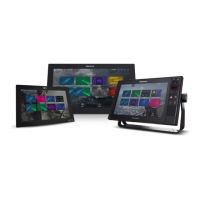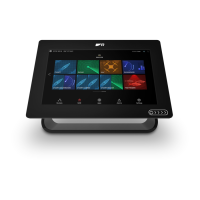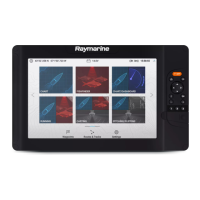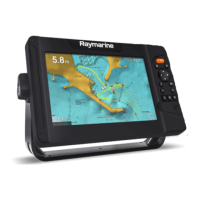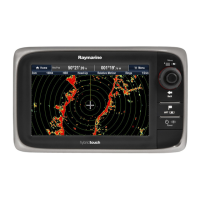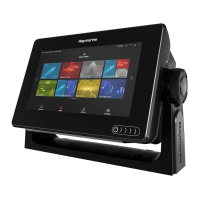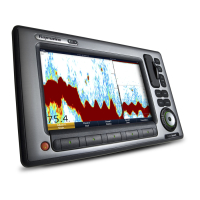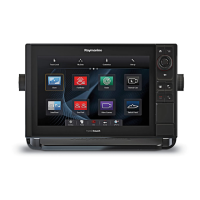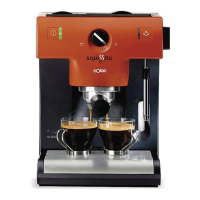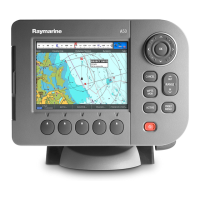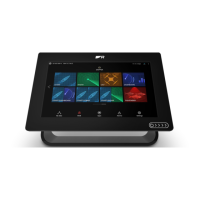Do you have a question about the Raymarine LightHouse Sport and is the answer not in the manual?
Legal statements regarding product accuracy, compatibility, and third-party data usage.
Initial setup steps including display controls, startup wizard, and basic configuration.
Accessing the shortcuts menu for quick functions like display brightness and screenshots.
How to change focus between multiple apps displayed on a page.
Details on compatible MicroSD card types, formats, and speed ratings for backup.
Managing and manually selecting data sources like GPS for optimal system performance.
Connecting and calibrating the EV-1 heading sensor for accurate vessel orientation.
Procedures for updating display software via memory card or internet connection.
Backing up and restoring user data like waypoints, routes, and tracks using a memory card.
Understanding the layout and elements of the main homescreen interface.
Description of core applications like Chart, Fishfinder, Dashboard, and Radar.
Customizing quick launch buttons to access frequently used app pages.
Personalizing homescreen app pages by renaming, deleting, or customizing them.
Navigating the settings menu for display, units, alarms, and import/export options.
Configuring and understanding different types of alarms and their severity indicators.
Adjusting settings for the internal GNSS (GPS) receiver, including differential positioning.
Using the built-in countdown or count-up timer function.
Marking and managing specific locations or points of interest on the chart.
Planning and navigating journeys by creating sequences of waypoints.
Recording and managing vessel's voyage history as a series of track points.
Understanding the chart display, vessel icon, and navigation aids.
Operating the chart app using motion mode and cursor mode controls.
Choosing electronic cartography from compatible chart cards like Navionics and C-MAP.
Utilizing preset modes like Simple, Detailed, Fishing, and Running for different uses.
Performing "Goto" operations to waypoints or locations and managing waypoint arrival alarms.
Sending navigation data to a connected Evolution autopilot system.
Tracking AIS targets and displaying their information on the chart.
Creating personal bathymetric charts in real-time using depth readings.
Visualizing underwater structure and targets using sonar data from a transducer.
Available sonar channels like RealVision, SideVision, DownVision, and Sonar.
Adjusting the operating frequency for supported sonar channels.
Available sonar channels for Element S displays, primarily the Sonar channel.
Operating the Fishfinder app in scrolling or pause/playback modes.
Marking points of interest directly from the Fishfinder display.
Viewing system data from connected sensors and equipment in customizable pages.
Cycling through different data pages available within the Dashboard app.
Configuring which data pages are visible or hidden in the Dashboard app.
Using compass and data indicator dials for navigation and sailing information.
Monitoring vessel course and deviations graphically on the dashboard.
Manually adding the Radar app icon to the main homescreen if it's not present.
Connecting a Quantum radar scanner to the display via Wi-Fi.
Launching the Radar app from the homescreen and understanding its initial states.
Placing the radar scanner into standby mode to stop transmitting.
Safely powering off the radar scanner.
Selecting optimized radar modes like Harbor, Coastal, Offshore, and Weather.
Tracking AIS targets and displaying them on the radar screen.
Identifying target distance and direction using radar range rings and indicators.
Setting up a guard zone to alert on detected radar returns within a specified area.
Accessing support services, warranty, service, and repairs via website, phone, or email.
Locating product variant and current software version information on the display.
Accessing detailed hardware, software, and cartography information for the display.
Saving display information to a memory card for diagnostic or reference purposes.
Checking product details for compatible connected devices on the network.
Saving system logs to a memory card for diagnostic purposes.
Finding video tutorials, training courses, and technical support forums for product usage.
